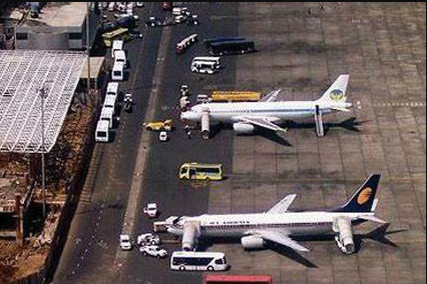
Mumbai Airport on High Alert After Mid-Air Hijack Scare
A dramatic and alarming incident recently unfolded at Mumbai International Airport, sending shockwaves across the aviation industry and passengers alike. What initially appeared to be a routine flight soon spiraled into a security scare that set off a high alert at the airport. The situation, which many initially feared was a potential hijacking, turned out to be a false alarm—yet the event highlighted critical aspects of aviation security protocols and the swift response of authorities.
The Incident: What Happened?
On a seemingly regular day, a passenger flight traveling from an international destination to Mumbai was midway through its journey when air traffic controllers received a distress signal from the cockpit. The crew reportedly mentioned a “hijack” scenario, raising immediate concerns among airport officials and national security agencies.
The details of the situation were still emerging at the time of reporting, but sources confirmed that the hijack alert was issued following a sudden shift in communication between the flight crew and ground control. While no clear details about the specific nature of the “threat” were disclosed immediately, the mere mention of a hijacking led authorities to activate emergency protocols.
Mumbai International Airport, one of the busiest airports in the world, is no stranger to heightened security measures, given the ever-present threat of terrorism and hijacking. However, this particular incident threw the system into overdrive as personnel scrambled to implement safety measures.
Immediate Response and High Alert
As soon as the hijack alert was received, airport security and local law enforcement agencies kicked into high gear. Mumbai Airport, like many major international hubs, has a well-established security protocol for handling such situations. The airport was placed under a high alert, with additional security personnel deployed across the premises. A significant portion of the airport’s resources was dedicated to preparing for a possible emergency landing, including coordinating with the National Security Guard (NSG), an elite counter-terrorism force.
Authorities also communicated with airlines and flight crews, ensuring that other incoming flights were briefed about the situation. The surrounding airspace was restricted temporarily, and a number of emergency measures were taken to safeguard passengers and flight crews, including holding back aircraft that were scheduled to land.
Meanwhile, the situation in the air remained uncertain as air traffic controllers maintained constant communication with the flight in question. High-ranking officials from the airport’s security teams and government agencies were put on standby, preparing for any potential escalation.
Security Protocols: How the Situation Was Handled Mumbai Airport
The swift and decisive actions taken by security and aviation authorities demonstrate the robustness of India’s airport security system. In these types of situations, there’s no room for hesitation, and every possible scenario must be anticipated and prepared for. Let’s take a closer look at some of the security measures that were activated:
- Increased Surveillance and Monitoring: As soon as the hijack scare was raised, surveillance systems at Mumbai Airport and in surrounding airspace were intensified. Security agencies closely monitored all flights arriving and departing from the airport to ensure there were no additional threats.
- Coordination Between Agencies: Aviation authorities, law enforcement, and national security teams quickly coordinated efforts to manage the situation. The National Security Guard (NSG), along with the Mumbai Police and airport security, were placed on high alert, with backup units prepared for any necessary intervention.
- Communication with Airlines: All airlines with flights scheduled to land at Mumbai were contacted and advised to remain on standby, preparing for possible delays. Airports across the country were also informed of the situation in real-time, with the Indian Air Force (IAF) ready to support if required.
- Passenger Safety Measures: In a hijacking or security breach scenario, the primary concern is always the safety of passengers. In the event that the alert had been confirmed, additional protocols such as lockdown procedures and immediate evacuation plans would have been implemented. Fortunately, no passengers were directly threatened during this particular scare.
- Aircraft Landing Protocol: In the event of an actual hijacking or similar crisis, special landing protocols are followed. In the case of Mumbai, the airport’s strategic location and security resources would have enabled authorities to quickly secure the aircraft upon landing and neutralize any threat.
The Aftermath: A False Alarm?
Once the aircraft was safely on the ground, the situation began to de-escalate. Upon investigation, authorities determined that the hijack scare had been a misunderstanding or a false alarm, although the exact details of what led to the communication breakdown are still unclear. The flight crew reportedly misinterpreted an emergency signal, or it may have been the result of a technical glitch that triggered the distress message.
Despite the lack of a genuine threat, the level of preparedness demonstrated by security forces was commendable. No one was harmed, and the situation was resolved without incident. However, the event served as a reminder of the high stakes involved in aviation security, especially in high-profile locations like Mumbai International Airport.
Mumbai Airport: Reassurance and Lessons Learned
While the hijack scare in Mumbai turned out to be a false alarm, the preparedness and response from aviation authorities demonstrated the importance of having stringent security protocols in place. It also highlighted how quickly and efficiently the airport staff and law enforcement could handle a potentially serious situation.
In light of this incident, officials have reassured the public that security at Mumbai Airport remains a top priority, with authorities continuing to refine their emergency response plans and communication systems. The aviation industry as a whole is constantly adapting to new security threats, and incidents like these serve as valuable learning experiences to help improve procedures for real-world scenarios.
Conclusion: A Close Call and a Reminder of Vigilance
Though the hijack alert at Mumbai Airport turned out to be a false alarm, the event serves as a stark reminder of the importance of aviation security and the vigilance required to keep passengers safe. It underscores the need for thorough preparation and the ability to react quickly and decisively in the face of potential threats.
As air travel continues to increase globally, incidents like this one—while rare—demonstrate just how important it is to remain alert and proactive. Airports like Mumbai’s are continually refining their strategies to ensure the highest levels of safety and security for all those who travel.
Conclusion
The mid-air hijack scare at Mumbai Airport was a tense moment that highlighted the importance of swift and effective security measures in the face of potential threats. While the situation ultimately turned out to be a false alarm, the response from authorities was a testament to the robust protocols in place to protect passengers. The incident served as both a cautionary tale and a reminder of the ever-present need for vigilance in aviation security.





